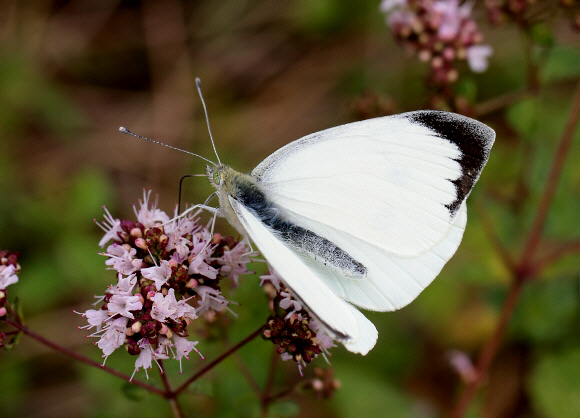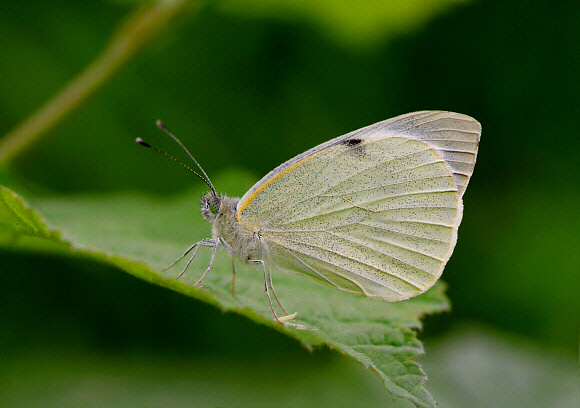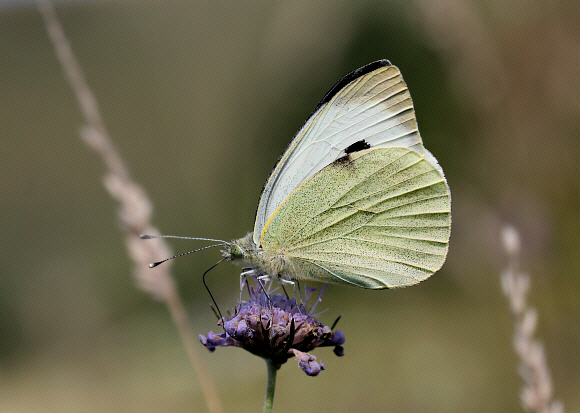
Introduction
The Large White, often inaccurately referred to as the Cabbage White, is found across the whole of Europe including the Mediterranean islands and the sub-arctic areas of Scandinavia. It also occurs in Morocco, Algeria, Tunisia, Libya, and across temperate Asia to the Himalaya mountains. It does not occur naturally beyond these regions, but was accidentally introduced to Chile.
Female Large Whites have a pair of prominent black spots in the median area of the forewings, but these are absent in the male. The spots are visible on the underside forewings of both sexes. Both sexes can be confused with the Small White Pieris rapae but in that species the dark markings are fainter – greyish rather than black – and the wingspan averages only 48mm as compared to the 63mm male and 70mm female of brassicae.
Pieris brassicae is widely reared in science laboratories where it is used in research by geneticists, biochemists and physiologists.
Large White Pieris brassicae Hartslock, Oxon – Adrian Hoskins
Migration
As with many other Pierines, the Large White is strongly migratory and can appear in virtually any habitat. In Britain it is commonly seen in coastal areas during migratory influxes, and often occurs in high numbers on flowery chalk grassland habitats in mid summer. Occasionally a mass migration takes place. On 31st July 2009 e.g. I witnessed a gathering of in excess of 250 migrants at Noar Hill in Hampshire. This site is an isolated hill with a great profusion of nectar sources and consequently a major refuelling stop for migrants.
At times I could stand in one spot and see 50 or more within a 10 metre radius. The insects were very active, often flying in migratory ‘strings’ of 7 or 8 at a time, pausing now and then to nectar avidly at marjoram, thistles and knapweed. On 9th August that year I witnessed an even greater concentration of migrants at Broughton Down, also in Hampshire. Over 700 Large Whites were present, many of which remained in the vicinity until the end of the month, e.g. when I revisited on 24th August in cool overcast weather there were still between 250-300 basking on herbage within a 50m x 30m patch of hillside.
The above numbers may sound impressive, but are nothing in comparison to the massive swarms which occurred in times past. There are several fascinating accounts of Large White migrations in C.B.Williams book ‘Insect Migration’, including this quote from Turpyn:
“In 1508, the 23rd year of Henry the 7th, the 9th of July being relyke Sonday, there was sene at Calleys ( Calais, France ) an in-numerable swarme of whit buttarflyes cominge out of the north-este and flyinge south-eastwards, so thicke as flakes of snowe, that men beinge a shutynge in St Petars fields without the towne of Calleys could not see the towne at foure of the clock in the aftarnone, they flew so highe and so thicke”. |
A more recent record tells of a swarm that descended on a small island in the Norfolk Broads:
“In August 1911 Professor Oliver was visiting a small island of about 2 acreson Sutton Broad in Norfolk. As he approached he saw the whole island was covered with fluttering white butterflies. All of them were caught on the sticky leaves of the insectivorous plant, sundew. Each small plant had captured 4 to 7 butterflies. Mostly they were still alive when Professor Oliver saw them. Several counts gave an average of about six million butterflies caught in this gigantic trap”. |
Habitats
Large Whites breed primarily in gardens, allotments and farmland where they often become a pest on cultivated Brassica ( cabbage, sprouts etc ). Because of its migratory lifestyle the butterfly is not restricted to these breeding sites, and appears commonly in a gamut of habitats including woodland rides, flowery hillsides, meadows, heaths and parks.
Lifecycle
There are usually 2 broods of this species in Britain, emerging in May and August; and sometimes a third brood emerging in October. The resident population is supplemented by migrants from Europe, which often arrive in large numbers during the spring and autumn. Thus it is possible to see adults of this species at any time from February to November.
The deep yellow skittle-shaped eggs are laid in batches of up to 100, on the underside of leaves of cabbage, sprout, nasturtium, sea kale and other wild or cultivated Cruciferae. The butterflies have been shown to be able to detect the presence of existing egg batches laid by other females, and will not normally lay additional batches on the same plant. The eggs hatch after about 10 days.
The caterpillars feed communally, reducing the leaves to a skeleton of veins before moving on to adjacent plants. They are a major pest, causing vast damage to Brassica crops and cabbages grown in gardens and allotments. They are conspicuously marked in black and yellow aposematic colours, and sequester mustard oils from the foodplants, which render them distasteful to avian predators. The mustard oils contain sulphur compounds, which bestow the larvae and their droppings with an acrid odour.
About 80 percent of larvae are killed by parasitoid wasps Apanteles glomeratus, which inject their eggs into them when they are quite small. The eggs hatch inside them, and the wasp grubs slowly devour the caterpillar’s flesh. When the grubs are fully grown they eat the caterpillar’s vital organs and kill it. They then break out through its skin leaving it to die, surrounded by a cluster of up to 80 tiny yellow fluffy wasp cocoons. The wasps hatch from the cocoons the next spring, and fly in search of more caterpillars to parasitise.
The pupa is formed in a vertical or horizontal position, attached by the cremaster and silken girdle, usually to walls, fences or tree trunks some distance away from the foodplant. Sometimes however pupation takes place on a stem or leaf of the foodplant. The pupa occurs in 2 colour forms. Those formed on stems or foliage are a unicolorous dull green, while those formed on artificial substrates are a pale buff hue, mottled with tiny black and yellow spots.
Many pupae when freshly formed and soft, are attacked by the parasitoid wasp Pteromalus puparum, which completes its entire lifecycle within the pupa. A single Large White pupa can produce a dozen or more of these tiny wasps, which are very beautiful creatures, metallic emerald green in colour.

Adult behaviour
Large Whites are among the first butterflies to take flight on cool or overcast days, often appearing an hour or more before other species awaken. In such weather conditions they spend long periods reflectance-basking, but take flight as soon as the clouds thin and there is a hint of warmth.
The adult butterflies are highly mobile, covering vast distances and exploring all available habitats in search of their larval foodplants and nectar sources. They have a powerful undulating flight which is undeterred by obstacles such as trees, bushes and buildings, over which they commonly fly.
Once they arrive at a flowery site they tend to stay for several days. In sunny weather they make short but regular flights, pausing briefly every few seconds to nectar at low growing flowers. Spring nectar sources include dandelion, bugle and wood spurge, while the summer brood butterflies favour thistles, knapweeds, marjoram, buddleia, scabious and hemp agrimony.
When a male encounters a gravid ( previously copulated ) female, she dives instantly into grasses or herbage, snaps her wings shut, and remains motionless, relying on her underside camouflage to hide from the male. He is usually able to find her however by detecting her pheromones and tries quite aggressively to force himself on her.
At first she responds by swaying slowly from side to side. This is quickly followed by her partly opening her wings, which prevents the male from making contact from the side. She then raises her abdomen at a steep angle ( possibly emitting a chemical deterrent at the same time ) to signal her refusal to mate, and the male then flies off.
I have often found copulated pairs at rest on low foliage or on robust flowers. In July 2009 I had the unusual experience of watching the precise moment at which copulation ended. I had been watching a mated pair for a couple of minutes, from a distance of several feet away when the pair parted. The male relaxed his anal claspers to release the female, which then dropped almost to the ground before flying away. The male remained in position for a while, then opened his wings to bask before flying in the opposite direction.
In overcast or hazy conditions the butterflies often bask on low foliage or amongst grasses, holding their wings half open to deflect solar energy onto the dark thorax.
The butterflies roost overnight in bushes or high in trees.

